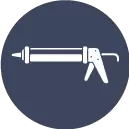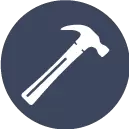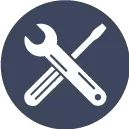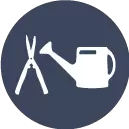Every landscaper or gardener definitely needs hand tools. These tools facilitate digging, cutting, planting and either cheering up or tamping down the outdoor spaces. They’re portable and battery-free, and they’re good for detailed tasks.
Digging and Moving Tools
These instruments help to get into the soil and shift things such as dirt, mulch and plants.
Shovels and Spades
Shovels are useful for scooping up and transporting soil or gravel. They are of curved blade and pointed. Spades have a flat edge and are best for sawing through grass and roots. Shovels are for moving, spades for the nice clean edges.
Garden Forks and Pitchforks
Garden forks have sturdy tines for loosening soil or lifting roots. Pitchforks with longer tines are employed for shifting mulch, hay, or compost. Both devices help loosen soil and transport light materials.
Hand Trowels and Scoops
Trowels are small instruments designed to plant, dig in tight spaces and weed. Scoops resemble mini shovels and can be used to fill pots or spread fertilizer. Those tools work really well if people are working near plants.
Cutting and Pruning Tools
Plants need to be pruned to be healthy. Cutting tools used to shape plants are pruners and shears, while those employed to remove dead or undesired parts are saws and loppers.
Pruners and Shears
Pruners, also known as secateurs, cut small branches and stems. Bypass pruners make clean cuts with their two-blade system; anvil pruners press the stem against a flat surface. Longer dual-edged shears are used for cutting back hedges and bushes.
Loppers and Pole Pruners
Loppers have long handles and cut larger branches. Tough cuts require a bit more power. Pole pruners can also trim high branches without ascending a ladder. These make it easier to control the shape of trees and tall shrubs.
Edgers and Manual Weeders
Edgers make a clean, straight line between the grass and garden beds. They are great for making tidy borders. Hand weeders extract plants at their root, making the beds easier to keep clean, without too much of a stoop.
Tools for Soil Care and Cultivation
Good soil helps plants to grow better. These tools can assist in breaking soil, incorporating compost and eliminating weeds.
Hoes and Cultivators
Hoes have flat, rectangle-shaped blades and assist in weeding and loosening soil. Cultivators have time to mix soil and air. Both tools keep the soil loose and rich for planting.
Hand Forks and Rakes
Hand forks are useful for loosening soil and removing weeds around plants being cultivated. Hand rakes remove small leaves and debris with no damage to roots. These are wonderful for use in small garden beds.
Dibbers and Bulb Planters
Dibbers are pointed sticks used to make holes in the ground for seeds or young plants. Bulb planters dig a hole to the proper depth for planting bulbs. These implements are useful in planting and in a rapid and clean manner.
Measuring and Layout Tools
With measuring tools, plan and place plants or paths in exactly the right spot.
Measuring Tapes and Rulers
Use tapes and rulers to measure the length of a distance between two plants, edges, or features. That extra couple inches help make sure everything is even and well-spaced.
Line Levels and Chalk Lines
Line levels ensure the ground or surface is level. Chalk lines snap a straight line on soil or grass. They assist in guiding where to plant rows or where to make cuts.
Stakes and Flags
Stakes and flags indicate where to plant or dig. They are also employed to highlight areas that need attention or to mark utilities. These are the little tools that really make the job less messy.
Safety and Comfort Accessories
These things protect their body and make their job easier and safer.
Gloves and Knee Pads
Gloves guard the hands against cuts, blisters and thorns. Knee pads will help kneel for long periods of time, especially when the ground is hard. They help relieve strain and make working much more comfortable.
Tool Belts and Pouches
Tool belts and pouches enable a worker to take small tools around with them. It saves time and keeps tools in close reach.
Sharpeners and Oils
Sharpeners keep the blades sharp, and sharpness makes cutting easier and cleaner. Oils are employed to prevent metal parts from rusting and tools from seizing up.
What to Look for in Good Hand Tools
The proper hand tool enables labor to be longer, more efficient, and to be enjoyed. There are a few things that are important when choosing tools.
Strong Materials
Strong materials, such as carbon steel, make good tools. These blades stay sharp longer and do not snap as readily. Handles constructed from hardwood, fiberglass or tough plastic are stronger and offer better ergonomics.
Comfortable Grip
Dolly handles with soft or cushioned grips will help prevent hand fatigue. Well-balanced tools are less fatiguing to use over long periods of time.
Right Tool for the Job
The right tool for the job saves time and material damage. For example, better off using a proper bulb planter than digging holes by hand. It’s wise to spend for tools that fit the work.
Tool Care and Maintenance
Taking care of tools helps them last longer and work better.
- Clean After Every Use: After using a tool, it’s a good idea to rinse away soil and plant pieces, then dry the tool. This prevents rust, and ensures that the blade stays sharp.
- Keep Blades Sharp: The duller the blade, the more difficult it is to cut. Inspect tools for loose parts and sharpen them frequently. Nip it in the bud, and you’ll avoid serious downstream problems later.
- Store Properly: The tools need to be placed in a dry place away from rain and moisture. Storing tools hanging or on a rack will prevent damage.
Conclusion
Hand tools are the very basic elements for a gardening task. They assist with digging, planting, trimming and planning. Landscapers can save time and work safely by selecting strong, comfortable tools, then taking care of them. With proper care, a set of good hand tools can last for years and tackle nearly any job in the garden or yard. And tools can last for years and handle almost any task in the garden or yard.







